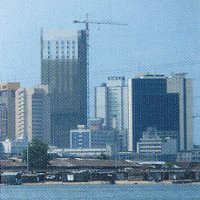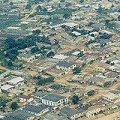
Lagos - background


 |  |
Victoria Island, the financial district
| |
The metropolis of Lagos is the largest melting pot of West Africa's ethnic groups and the commercial centre of a nation of 108 million inhabitants. Lagos is Nigeria's oldest and largest city. It is also the largest city in tropical Africa. In 1991, Lagos gave up its role as the capital city of Nigeria to a smaller town named Abuja. Nonetheless, Lagos remains unrivalled as the centre for commerce and finance in Nigeria.
The heart of Lagos is Lagos Island, where all the major banks, department stores and restaurants are located. Most of the embassies and large houses are on Victoria and Ikoyi Islands. The three islands together make up most of downtown Lagos. The rest of the city, occupied by three-quarters of the population, is of very poor housing quality and very high density (up to 200,000 per km²). Most families live in single rooms of sometimes less than 8 m², sharing cooking and sanitary facilities with neighbours.
 |  | | |
Agglomeration and overpopulation complicate the development of Lagos' suburbs
|
There is no statistical data on the population of Lagos, although UN estimates put the number of inhabitants at over 13.4 million in the year 2000, which would make Lagos the seventh most populated city in the world. The same UN statistics reveal Lagos to be the fastest growing city in the world, and estimate that its population will exceed 20 million by 2020. If these predictions are accurate, Lagos will become the world´s third most populated city.
Lagos was founded as a Yoruba fishing and farming settlement in the 17th century. By 1861, when British colonialisation began, Lagos grew to about 20,000 inhabitants and established a reputation as a shipping and trading centre and as a place of refuge from local wars. The city became the capital of Southern Nigeria in 1906. In 1914, Southern Nigeria and Northern Nigeria were joined to form the Colony and Protectorate of Nigeria. Head of the administration was the Governor-General, residing in the capital Lagos.
The population of Lagos reached 700,000 in 1960, when Nigeria became independent. Since then, the city has grown steadily, although it lost its role as the capital city in December 1991. The main reason was that Lagos lay within the home area of one of the country's largest ethnic groups.
The new capital, Abuja, was constructed on a largely unoccupied site near the country's centre, between the home areas of the three largest ethnic groups.
Last update: 16 April 2013

 |  | 
Lagos

| | • | Introduction (http://www.esa.int/SPECIALS/Eduspace_Global_EN/SEMVJSTTGOF_0.html) |  | 
Exercises

| | • | Worksheet introduction (http://www.esa.int/SPECIALS/Eduspace_Global_EN/SEM3F7UTGOF_0.html) |  | | • | Exercises using Landsat data (http://www.esa.int/SPECIALS/Eduspace_Global_EN/SEM3G7UTGOF_0.html) |  | | • | Exercises using Ikonos data (http://www.esa.int/SPECIALS/Eduspace_Global_EN/SEMQQ5UTGOF_0.html) |  | 
Eduspace - Software

| | • | LEOWorks 3 (http://esamultimedia.esa.int/multimedia/LEOWorks3.exe) |  | 
Eduspace - Download

| | • | lagos.zip (http://esamultimedia.esa.int/multimedia/eduspace/lagos.zip) |  | | • | Technical information about Landsat bands (PDF) (http://esamultimedia.esa.int/docs/eduspace/Technical_data_LANDSAT_bands.pdf) |  |

|

